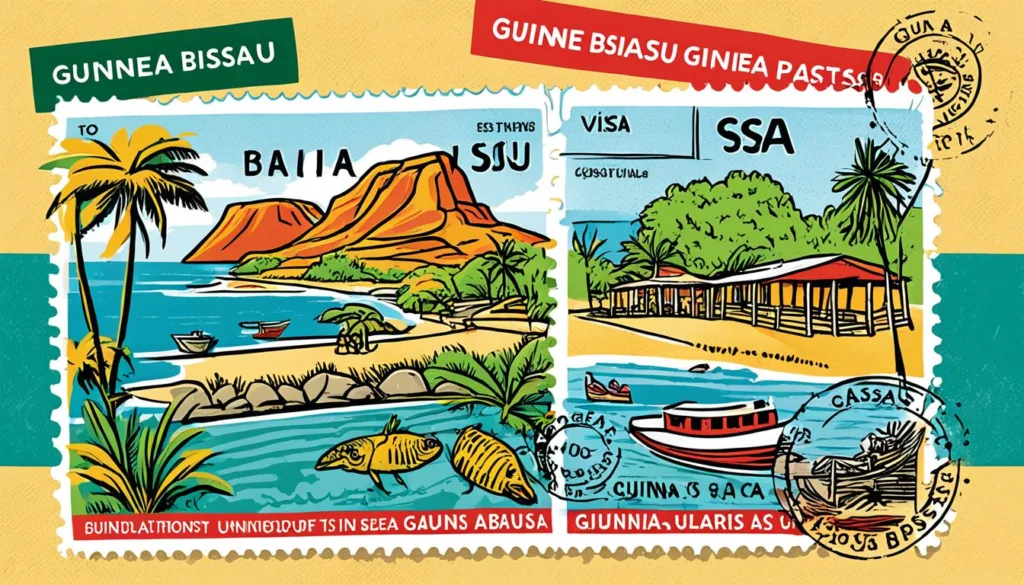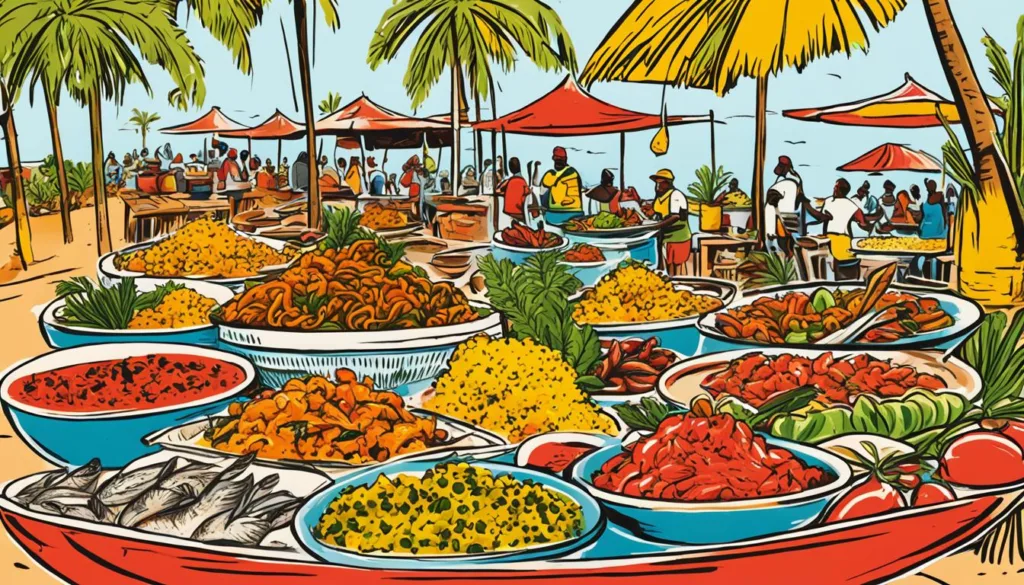When planning a unique getaway, finding the perfect calendar slot can be the difference between a good vacation and an unforgettable one. Have you ever considered Guinea-Bissau for your next travel endeavor? Tucked away on West Africa’s sun-drenched coast, this hidden gem offers a rare tableau of cultural festivities and wildlife sightings. However, with its tropical allure comes the essential question of timing. What’s the best time to visit Guinea-Bissau, and how do its equatorial rhythms influence your travel experience?
Believe it or not, Guinea-Bissau weather patterns carve out an ideal tourism season beyond what most might expect. From the misty canopies of the lush Bijagós archipelago, a designated biosphere reserve, to the charismatic yet weathered streets of Bissau – the capital city adorned in its Portuguese colonial vestiges – each moment is seasonally orchestrated. Engaging in Guinea-Bissau vacation planning is more than just booking flights and accommodations; it’s about aligning with a time that opens doors to the country’s soul, from its majestic saltwater hippos to vibrant cultural tapestries.
For the keen traveler, that magical window spans from November to April, striking a balance between environmental comfort and accessibility. The drier skies not only make for smoother journeys but also ensure that the country’s wildlife and festivities are on full, resplendent display. Let’s delve into the details that transform a trip into a narrative of adventure and discovery, woven seamlessly into the fabric of Guinea-Bissau’s unique appeal.
Key Takeaways
- Optimal travel period to Guinea-Bissau is from November to April for better weather conditions.
- The Bijagós archipelago is a must-visit for its biodiversity and distinct cultural experiences.
- Avoiding the rainy season ensures a more enjoyable and accessible interaction with the destination.
- Aligning your visit with cultural events and wildlife patterns maximizes the trip’s potential.
- Advance planning for Guinea-Bissau’s tropical weather can greatly enhance your travel experience.
Discovering Guinea-Bissau’s Rich Cultural Tapestry
Embarking on a voyage to Guinea-Bissau unveils a world brimming with cultural riches and time-honored traditions. Rooted within the Bijagos Archipelago, visitors can immerse themselves in an environment where ancient customs persist and nature intertwines elegantly with daily life, offering unique experiences for those seeking authenticity. Here’s a glimpse into the vitality of Bijago culture and its entwined ecological wisdom, magnifying the islands as a sanctuary of unparalleled heritage.
Bijagos Archipelago: A Cultural Haven
Encompassing a myriad of islands, each with its own identity, the Bijagos Archipelago is a showcase of Guinea-Bissau’s vibrant heart. With **Guinea-Bissau travel tips** in hand, adventurers learn that only a fraction of these gems are inhabited. Yet, they hold a mosaic of ceremonies, rites, and an enduring Bijago culture that resonates through generations. This UNESCO World Heritage Site cradles a harmonious blend of people and wildlife, inviting travelers to witness a way of life preserved beyond the tides of time.
Matriarchy and Spiritual Beliefs in Local Societies
In the scattered isles of Bijagos, matriarchy forms the fabric of social order. Here, women hold the reins of power, leading in realms of economics and law, creating a fascinating societal structure for visitors to behold. Spiritual beliefs are profoundly interwoven with these customs, ascribing significant respect to the lifespring of nature—a reverence that is faithfully passed on through generations, ensuring the continuity of a way of life that honors its roots.
Preservation Through Tradition: Bijagos’ Environmental Sagacity
Among the Bijagos, environmental conservation is not a modern concept but an age-old practice steeped in the wisdom of their forebears. **Bijagos Archipelago** travel becomes an educational odyssey, revealing how sacred trees and entire islands act as fortresses, guarding the biodiversity against the erosive forces of time. The intricate relationship between the people and ecosystem morphs into a vibrant tapestry of living traditions, highlighting how **Guinea-Bissau cultural festivals** serve as a bastion for the preservation of both culture and nature.
As you plan your cultural expedition, harmonizing your itinerary with the timings of the Bijagos’ festivities is instrumental. To experience the pulse of the archipelago, tapping into travel wisdom ensures you witness the ceremonial splendor and ecological beauty in their most pristine form, making your journey to Guinea-Bissau a tapestry of unforgettable memories.
An Ecological Paradise: When to Witness Guinea-Bissau’s Biodiversity
Welcome to the serene enclaves of the Bijagos Archipelago, where the unparalleled beauty of Guinea-Bissau’s biodiversity beckons nature enthusiasts and casual explorers alike. The islands serve as an ecological Eden, hosting species as enchanting as the saltwater hippo and the green sea turtle–the flag bearers of Bijagos Archipelago wildlife.
The climate of Guinea-Bissau plays a pivotal role in scheduling your visit to this West African nation. This Guinea-Bissau Climate Guide suggests that to experience the vibrancy of the archipelago’s wildlife, aligning your travel plans with key ecological moments is essential.

| Season | Wildlife Events | Visitor’s Experience |
|---|---|---|
| August – February | Green Sea Turtle Nesting | Witness the largest colony of nesting turtles on the Atlantic coast. |
| October – early February | Saltwater Hippo Spotting | Observe the hippos’ unique behaviors as they traverse between islands. |
| November – April | General Wildlife Viewing | Enjoy comfortable weather with better accessibility to diverse habitats. |
It is essential to understand that it’s not the footsteps of explorers that pose the greatest threat to this region’s wildlife. Rather it is the disruptive influence of external ideologies conflicting with the local conservation ethos. So be a conscientious traveler, respecting both the Guinea-Bissau biodiversity and the sacred customs that protect it.
To ensure a responsible and awe-inspiring visit, remember that each season offers its own unique symphony of natural wonder. Whether it’s the sight of turtles embarking on their life’s voyage or the majestic saltwater hippos against the sunset, the Bijagos Archipelago awaits your respect and your sense of adventure.
Best Time to Visit Guinea-Bissau for Wildlife and Cultural Experiences
When it comes to unveiling the hidden treasures of West Africa, timing is everything. Guinea-Bissau, with its melange of vibrant wildlife and rich cultural festivities, offers a palette of experiences for the mindful traveler. Delving into the ideal time to visit Guinea-Bissau requires understanding the rhythm of nature and the cadence of culture that defines this unique destination.
Bijagos Archipelago: Peak Seasons for Unique Fauna
The Bijagos Archipelago emerges as a beacon for biodiversity, welcoming nature enthusiasts with seasonal spectacles. The ideal time to visit Guinea-Bissau for wildlife observation pristinely extends from August to February. Within this timeframe, one has the indelible opportunity to witness green sea turtles embarking on their time-honored nesting rituals and the elusive saltwater hippos in their natural aquatic abodes.
Cultural Festivals and Events: Ideal Timing for Participation
The cultural heart of Guinea-Bissau beats loudest during its traditional festivities, whose dates are intertwined with lunar cycles and seasonal shifts. Engaging with the vibrant tapestry of local life necessitates aligning one’s travel schedule with the calendar of events. Whether it’s the Carnival of Bissau or the ancestral narratives spun during the Regatta of the Bijagos, partaking in these celebrations affords a gateway to the soul of Guinea-Bissau.
Weather Patterns and Travel Comfort in Guinea-Bissau
Guinea-Bissau’s weather patterns assert a commanding influence on trip planning. The nation’s tropical climate translates to a window from November to April when the skies clear, and the land breathes with easier passage. Guinea-Bissau weather patterns are kindest in these months, proffering lower humidity and scarce rainfall, thereby securing travel comfort and uninterrupted immersion into the ecosystem and ethos of this captivating country.
Embarking on Guinea-Bissau trip planning is an exciting foray into an undisturbed world where nature and culture coalesce. With strategic timing, one’s sojourn into this West African jewel becomes not just a passage through space, but a journey woven with the threads of unforgettable experiences.
Practical Tips for Your Guinea-Bissau Travel Adventure
Embarking on an adventure to Guinea-Bissau requires careful preparation to ensure a seamless and enjoyable experience. Here are some invaluable insights aimed at aiding travelers in their Guinea-Bissau trip planning efforts.
Visa and Entry Requirements: Planning Ahead
Traveling to Guinea-Bissau mandates possession of a biometric visa. Potential visitors can obtain this visa through a Guinean embassy in their country or upon arrival in Bissau. It’s preferred to manage this process before departure to alleviate any unnecessary stress during your travels.

Health Precautions: Vaccinations and Preventive Measures
Given the prevalence of yellow fever in Guinea-Bissau, all visitors must present a valid vaccination certificate. Additionally, obtaining malaria prophylaxis prior to your departure is strongly advised due to the region’s significant malaria risk. Securing comprehensive travel insurance that includes medical emergencies is also prudent, considering the limited healthcare services within the country.
Local Currency and Payment Methods: Navigating the Economy
The West African CFA Franc (XOF) serves as the legal tender. It’s important to recognize that Guinea-Bissau operates mainly as a cash-based economy. ATM availability is scarce, and credit card acceptance is unusual, particularly outside of Bissau. Therefore, securing adequate cash before your journey is essential for a hassle-free trip.
Learning some basic phrases in Portuguese or French can vastly improve your communications, as they are the official and most commonly spoken languages in Guinea-Bissau.
Embarking on Your Journey: How to Arrive and Where to Stay
Initiating your Guinea-Bissau vacation planning usually begins with a flight to Osvaldo Vieira International Airport, the primary gateway near the capital, Bissau. Although direct flights are not common, travelers can often find routes through Dakar or Lisbon. Once on the ground, the variety of Bissau accommodation caters to diverse tastes and preferences. Whether seeking the rustic charm of lodgings on the remote Bijagós islands or the contemporary comforts of city hotels, there’s an array to choose from.

When it comes to experiencing the Guinea-Bissau local cuisine, the culinary adventures are plentiful, with traditional dishes that celebrate the country’s affinity for rice and fish. Navigating Bissau after dusk can be challenging, given the sporadic power outages and minimal streetlights. It’s advisable to plan accordingly to minimize nocturnal travel and to strictly adhere to marked roads to avoid areas contaminated with mines.
For those contemplating driving, hiring a car is an option, but it’s worth noting that the condition of roads can vary. Opting for guided tours can provide peace of mind and a smoother travel journey, ensuring you reach your destinations safely and punctually.
- Direct flights to Bissau are scarce; connections often made via Dakar or Lisbon
- Range of accommodations catering to various preferences and budgets
- Authentic local cuisine centered on rice and fish dishes
- Consider guided tours for safer and more reliable travel within the country
Conclusion
Embarking on a Guinea-Bissau travel adventure offers the intrepid traveler an opportunity to connect with the world in a rare and enriching way. This gem in West Africa is uncrowded by mass tourism, allowing for genuine moments of discovery and interaction with its rich tapestry of culture and nature. It’s essential to weave responsible travel in Guinea-Bissau into the fabric of your visit, by planning the trip carefully, respecting local customs, and acknowledging your impact as a visitor. Such mindfulness ensures the preservation of this country’s irreplaceable heritage, for future generations to admire and experience.
Immersing Yourself in the Unique Timelessness of Guinea-Bissau
The immersive travel experience promised by Guinea-Bissau is both humbling and exhilarating. The mélange of traditional practices, community ceremonies, and the vibrant wildlife found in settings like the Bijagos Archipelago, provides a profound understanding of the phrase ‘unique timelessness’. To truly immerse oneself in the essence of Guinea-Bissau, one must travel with an open heart, ready to learn and embrace the extraordinary tempo of life found here.
Responsible Travel: Preserving Guinea-Bissau’s Heritage
As explorers of this beautiful planet, it is our duty to engage in responsible travel in Guinea-Bissau. Strive to leave a light footprint on the environment and support the local economy in ethical ways. Practice sustainability, from the transport you choose within the country to the souvenirs you take home. In this way, each journey made to Guinea-Bissau aids in safeguarding its cultural and ecological treasures, ensuring they continue to thrive long after our visit concludes.
FAQ
What is the best time to visit Guinea-Bissau?
The best time to visit Guinea-Bissau is from November to April, during the dry season, which offers optimal weather conditions for travel and wildlife observation.
Can you give me some travel tips for visiting the Bijagos Archipelago?
Schedule your visit to coincide with cultural festivals for a unique experience, respect local customs, and be prepared for minimal infrastructure with cash and essential supplies.
What are some key cultural aspects of the Bijagos Archipelago?
The Bijagos Archipelago is known for its matriarchal society, spiritual beliefs, and preservation through tradition, with sacred areas dedicated to protecting the biodiversity.
When is the best time to witness wildlife in the Bijagos Archipelago?
The peak season for wildlife in the Bijagos Archipelago is from August to February, ideal for observing green sea turtles nesting and saltwater hippos in their natural habitats.
What are the visa and entry requirements for traveling to Guinea-Bissau?
Visitors must acquire a biometric visa, which can be obtained before departure at a Guinean embassy or upon arrival in Bissau. A valid passport is also essential.
Are there any required vaccinations or health precautions for Guinea-Bissau?
Yes, yellow fever vaccination is mandatory, and malaria prophylaxis is recommended. It’s advisable to arrange these before your trip.
What should I know about the local currency and payment methods in Guinea-Bissau?
Guinea-Bissau uses the West African CFA Franc (XOF), and it’s primarily a cash economy. Access to ATMs is limited, and credit card acceptance is rare.
How do I arrive in Guinea-Bissau, and what are the accommodation options?
Entry is usually through Osvaldo Vieira International Airport with flights often routed through Dakar or Lisbon. Accommodation ranges from basic lodgings to more comfortable hotels in Bissau.
How can I immerse myself in the unique timelessness of Guinea-Bissau?
Engage with the local culture and customs, participate in cultural events, explore the biodiversity, and practice responsible tourism to preserve the area’s heritage.
What does responsible travel mean in the context of Guinea-Bissau?
Responsible travel in Guinea-Bissau involves respecting local customs, supporting conservation efforts, minimizing environmental impact, and contributing to the local economy in a positive way.






